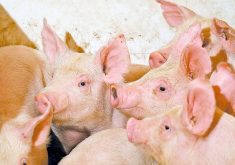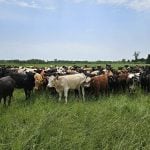Chicago | Reuters –– Chicago Mercantile Exchange live cattle futures edged higher on Friday, capping their first weekly gain in five weeks as wintry weather across the central U.S. slowed the movement of cattle to market.
Storms from New Mexico to Illinois that brought ice, snow and pounding rain caused flooding, killing at least three people. Icy roads and bridges also halted cattle shipments, forcing at least two slaughterhouses in Texas and Kansas to cancel a shift, traders said.
Feedlots were left muddy and operators were expected to push beef packers to pay up for their cattle while slaughterhouses in the southern U.S. Plains could be shorthanded next week. The U.S. Department of Agriculture said the cattle slaughter on Friday was 98,000 head, down from 108,000 head a week ago and 105,000 on the same day last year.
Read Also

U.S. grains: Soybean futures set two-week high on US weather worry, soyoil rally
Chicago Board of Trade soybean futures touched a two-week high on Friday on worries that heat may threaten U.S. crops and expectations that the country’s biofuel policy would boost demand for soyoil, analysts said.
“Cattle are wet and miserable and they don’t look good,” livestock analyst David Hales said.
“No one I talked to is interested in selling cattle today. That will take the tonnage off,” Hales said of beef production.
Live cattle for December delivery finished 0.875 cent higher at 131.825 cents/lb., resulting in a 1.6 per cent weekly gain. January feeder cattle futures were 1.05 cent higher at 166.025 cents/lb., with the 1.5 per cent weekly gain also snapping what had been four straight weeks of declines.
USDA showed slightly higher wholesale beef prices, which provided further hints that the choice beef cutout may have reached a bottom after hitting the lowest levels in roughly 23 months early this week.
“We have seen boxed beef prices, I don’t know if I’d call it a bottom, but they’ve turned around a little bit,” said Craig VanDyke, analyst at Top Third Ag Marketing.
Lean hog futures were lower in bull-spreading, with front-month December futures edging down 0.075 cent, to 58.725 cents/lb., while more active February futures eased 0.4 cent, to 57.675.
Hog prices are hovering near six-year lows, and some investors suggested that prices also may be nearing an at least short-term bottom. The spreads indicated better demand, with the front-month contract priced at a premium to deferred contracts for the first time in about 1-1/2 months.
VanDyke said the move in hogs came despite lacklustre weekly U.S. pork export sales, with sales of 8,978 tonnes in the week ended Nov. 19 less than half of the 20,669 tonnes sold in the previous week.
— Michael Hirtzer reports on agriculture and ag commodity markets for Reuters from Chicago.


















